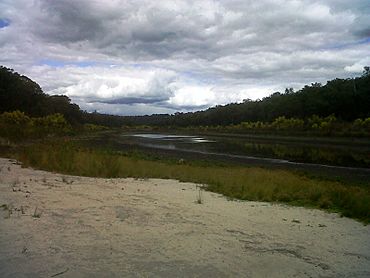Thirlmere Lakes National Park facts for kids
Quick facts for kids Thirlmere Lakes National ParkNew South Wales |
|
|---|---|
|
IUCN Category II (National Park)
|
|

Thirlmere Lakes
|
|
| Nearest town or city | Couridjah |
| Established | 7 April 1972 |
| Area | 6.29 km2 (2.4 sq mi) |
| Managing authorities | NSW National Parks and Wildlife Service |
| Website | Thirlmere Lakes National Park |
| See also | Protected areas of New South Wales |
The Thirlmere Lakes National Park is a special protected area in New South Wales, Australia. It is like a natural treasure chest! This park is found in the Macarthur region. It is about 70 kilometers (43 miles) southwest of Sydney.
The park covers about 629 hectares (1,550 acres) of land. It was first set up in 1972 as a state park. Later, it became a national park. In 2000, Thirlmere Lakes National Park became part of something even bigger. It joined seven other protected areas to form the Greater Blue Mountains Area. This whole area is so important that UNESCO named it a World Heritage Site. Thirlmere Lakes is the smallest of these eight special places.
Contents
What Makes Thirlmere Lakes Special?
The most important parts of this park are its beautiful lakes. Scientists believe these lakes formed about 15 million years ago. This happened because of big changes in the Earth's land. The land lifted, which mostly cut the lakes off from nearby rivers. Now, only a small stream called Blue Gum Creek flows out of them. This creek goes into the Little River in the nearby Nattai National Park.
Amazing Plants and Animals
The lakes and the land around them are home to many unusual plants and animals. Some of these are very rare!
- Rare Water Creatures: You can find a special freshwater sponge here. It is called Radiospongilla sceptroides. What's interesting is that you won't find any freshwater snails in these lakes!
- Unique Water Plants: The lakes have a rare plant called watershield (Brasenia schreberi). The edges of the lakes are lined with other rare plants. These include the grey sedge (Lepironia articulata) and the wooly frogsmouth lily (Philydrum lanuginosum).
- Bird Haven: This park is a safe place for birds. The rare Australasian bittern (Botaurus poiciloptilus) lives here. You might also see the Latham's snipe (Gallinago hardwickii). This bird travels long distances to visit the park.
Forests Around the Lakes
The areas around the lakes have open sclerophyll forests. These are forests with tough, hard-leaved trees.
- Main Trees: Close to the lakes, you will see rough-barked apple trees (Angophora floribunda). On higher ground, there are sydney peppermint trees (Eucalyptus piperita) and red bloodwood trees (Corymbia gummifera).
- Undergrowth Plants: Below the tall trees, there are many plants common to the Sydney sandstone areas. These include different types of Banksia and Acacia plants. You can also find beautiful pea flowers and the famous New South Wales waratah (Telopea speciosissima).
Climate at Thirlmere Lakes
| Weather chart for Thirlmere Lakes National Park | |||||||||||||||||||||||||||||||||||||||||||||||
|---|---|---|---|---|---|---|---|---|---|---|---|---|---|---|---|---|---|---|---|---|---|---|---|---|---|---|---|---|---|---|---|---|---|---|---|---|---|---|---|---|---|---|---|---|---|---|---|
| J | F | M | A | M | J | J | A | S | O | N | D | ||||||||||||||||||||||||||||||||||||
|
123
31
13
|
215
24
15
|
164
23
12
|
119
20
10
|
54
17
7
|
177
12
5
|
34
13
4
|
97
14
7
|
53
20
8
|
53
26
10
|
87
28
11
|
112
28
14
|
||||||||||||||||||||||||||||||||||||
| temperatures in °C precipitation totals in mm |
|||||||||||||||||||||||||||||||||||||||||||||||
|
Imperial conversion
|
|||||||||||||||||||||||||||||||||||||||||||||||
The climate chart above shows the average weather conditions for Thirlmere Lakes National Park. It helps us understand the temperatures and rainfall throughout the year.
A Challenge for the Lakes
Sadly, two of the lakes in the park have dried up. This has happened since the mid-1980s. The main reason is that water has been taken from the ground nearby. This water was removed because of coal mining at the Tahmoor Colliery.
The local community is working hard to help the lakes. They are looking into ways to bring the water back. This will be a big project and might take many decades to fix. Everyone hopes these beautiful lakes can be saved for the future.


